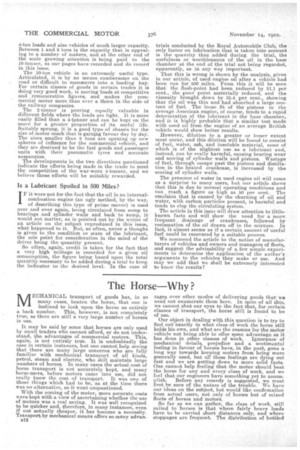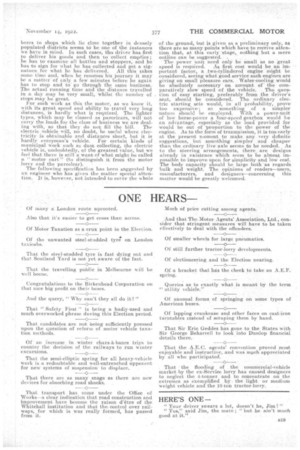The Horse—Why ?
Page 2

Page 3

If you've noticed an error in this article please click here to report it so we can fix it.
MECHANICAL transport of goods has, in so many cases, beaten the horse, that one is inclined to look upon the horse as entirely a back number This, however, is not completely true, as there are still a very large number of horses in use.
It may be said by some that horses are only used by small traders who cannot afford, or do not understand, the advantages of commercial motors. This, again, is not entirely true. It is undoubtedly the case in certain instances, but one cannot help seeing that there are many large concerns who are fully familiar with mechanical transport of all kinds, petrol, steam and electric, who still maintain large numbers of horses. In many eases the actual cost of horse transport is not accurately kept, and many horse-users, before motors came into use, did not really know the cost of transport. It was one of those things which had to be, as at the time there was no alternative, so it went unquestioned.
With the coming of the motor, more accurate costs were kept with a view of ascertaining whether the use of motors was a real saving. It was well recognized to be quicker and, therefore, in many instances, even if not actually cheaper, it has become a necessity. Transport by mechanical means offers so many advan
BIS
tages over other modes of delivering goods that we need not enumerate them here. In spite of all this, we cannot shut our eyes to the fact that, for certain classes of transport, the horse stilt is found to be of use.
Our object in dealing with this question is to try to find out'exaetly in what class of work the horse still holds his awn, and what are the reasons for the motor vehicle not being able to offer some advantage as it has done in other classes of work. Ignorance of mechanical details, prejudice and a sentimental feeling in favour of horses have, in the past, gone a long way towards keeping motors from being more generally used, but all these feelings are dying out fast and we are getting down to more solid facts. One cannot help feeling that the motor should beat the horse for any and every class of work, and we feel that our engineers have something yet to accomplish. Before any remedy is suggested, we must first be sure of the nature of the trouble. We have our ideas on the subject, but would like confirmation from actual users, not only of horses but of mixed fleets of horses and motors.
So far as we can gather, the class of work, still suited to horses is that where fairly heavy loads have to be carried short distances only, and where stoppages are frequent. The distribution of bottled
beers to shops which lie close together in, densely populated districts seems te be one of the instances we have in mind. In such cases, thc4 driver has•first to deliver his goods and then to -collect empties; he has to examine. all bottles and stoppers, and he has to sign for what he has-•collected and get a sig. nature_ for what he has delivered. All this takes some time and, when he reauMes, his journey it may be a matter of (Allya few minutes before he again has to stop and to go through the same business.. The actual running time and the .distance travelled in a day may be very small, whilst the number of stops may be great.
For such 'work as this the motor, as we know it, with its great speed and ability to travel very long distances, is hardly what is required. The lighter types, which may be classed as parcelcars, will not carry the loads for the class of business we are deal
ing with, so that they do not fill the bill. The electric vehicle will, no doubt, be useful where electricity is obtainable and distances short, but it is hardly everyman's vehicle. For certain kinds of municipal work such as. dust collecting, the electric vehicle is, -undoubtedly, of the greatest value, but we feel that there is still a want of what might be called
'` motor cart ' (to distinguish it from the motor lorry and the parcelcar).
The following specification hAs been suggested by an engineer who has given the matter special attention. It is, however, not intended to cover the whole
of the ground, but is given as a preliminary only, as there are so many Points which have to receive attention that, at this early' stage, nothing but a mere outline, can be suggested. ..
• The rower unit need only be small as no great speed is required. AA first cost would be an important factor,. a ,two-eylindered engine might be considered, seeing what good service such engines are giving on small -pleasure cars. • Water-cooling would be Absolutely necessary on account of the comparatively slow speed of the vehicle. The question of easy starting, preferably from the driver's seat, should be considered. The ordinary electric starting sets would, in all probability, prove. too expensive,. so something • of a simpler nature should be employed. With a power-unit of low. horse-power a four-speed gearbox would be an advantage, especially as the loadprovided for would be out of 'proportion to the power of the engine. Aa to the form of transmission, it is toe early at the present moment to make any very definite suggestions, but somethingsimpler and cheaper than the, ordinarylive axle seerfis to be needed. As to the steering arrangements, there are designs already in existence which _seem to be almost impossible to improve upon for simplicity and low cost. The body capacity should he large both-as regards bulk and weight. The opinions of readers—users, manufacturers, and designers—concerning this matter would he greatly welcomed.
































